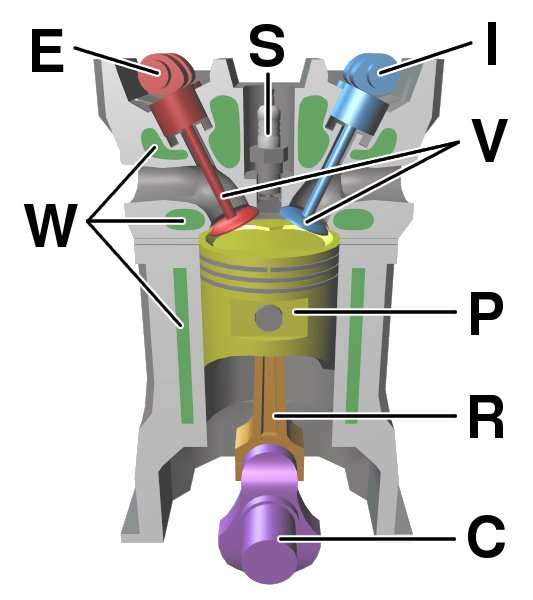is an engine driven directly by the expansion of
combustion gases, rather than by an
externally produced medium, such as steam. Basic versions of the internal
combustion engine are: gasoline engine and gas engine (spark
ignition), diesel engine (compression
ignition), and gas turbine (continuous combustion). Diesel
compression-ignition engines are more fuel-efficient than gasoline engines
because compression ratios are higher,
and because the absence of air throttling improves
volumetric efficiency. Gasoline,
gas (natural gas,
propane), and diesel engines operate either on a four-stroke cycle
(Otto cycle) or a two-stroke cycle. Most gasoline engines are of
the four-stroke type, with operation as follows: (1) intake - piston moves
down the cylinder, drawing in a fuel-air mixture through the intake valve;
(2) compression - all valves closed, piston moves up, compressing the
fuel-air mixture, and spark ignites mixture near top of stroke; (3) power -
rapid expansion of hot combustion gases drives piston down, all valves
remain closed; (4) exhaust - exhaust valve opens and piston returns, forcing
out spent gases.

The diesel four-stroke cycle differs in that only air is
admitted on the intake stroke, fuel is injected at the top of the
compression stroke, and the fuel-air mixture is ignited by the heat of
compression rather than by an electric spark. The four-stroke-cycle engine
has certain advantages over a two-stroke, including higher piston speeds,
wider variation in speed and load, cooler pistons, no fuel lost through the
exhaust, and lower fuel consumption. l
The two-stroke cycle eliminates the intake and exhaust strokes of the
four-stroke cycle. As the piston ascends, it compresses the charge in the
cylinder, while simultaneously drawing a new fuel-air charge into the
crankcase, which is air-tight. (In the diesel two-stroke cycle, only air is
drawn in; the fuel is injected at the top of the compression stroke.) After
ignition, the piston descends on the power stroke, simultaneously
compressing the fresh charge in the crankcase. Toward the end of the power
stroke, intake ports in the piston skirt admit a new fuel-air charge that
sweeps exhaust products from the cylinder through exhaust ports; this means
of flushing out exhaust gases is called "scavenging". Because the crankcase
is needed to contain the intake charge, it cannot double as an oil
reservoir. Therefore, lubrication is generally supplied by oil that is
pre-mixed with the fuel. An important advantage of the two-stroke-cycle
engine is that it offers twice as many power strokes per cycle and, thus,
greater output for the same displacement and speed. Because two-stroke
engines are light in relation to their output, they are frequently used
where small engines are desirable, as in chain saws, outboard motors, and
lawn mowers. Many commercial, industrial, and railroad diesel engines are
also of the two-stroke type. l
Gas turbines differ from conventional internal combustion engines in that a
continuous stream of hot gases is directed at the blades of a rotor. A
compressor section supplies air to a combustion chamber into which fuel is
sprayed, maintaining continuous combustion. The resulting hot gases expand
through the turbine unit, turning the rotor and driveshaft.
Also see fuel injection,
turbine.

Components of a typical, four stroke cycle, internal
combustion piston engine.
E - Exhaust camshaft
I - Intake camshaft
S - Spark plug
V - Valves
P - Piston
R - Connecting rod
C - Crankshaft
W - Water jacket for coolant flow.